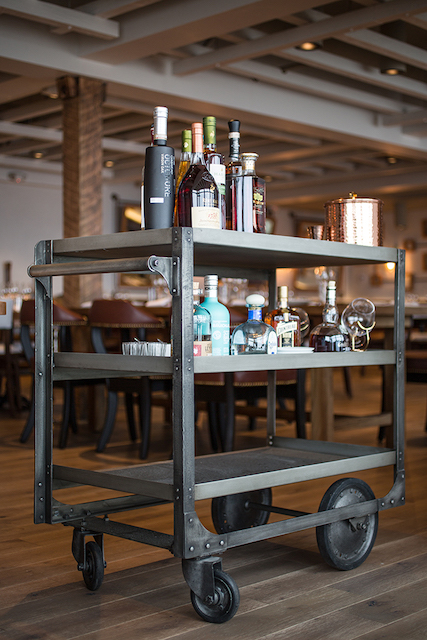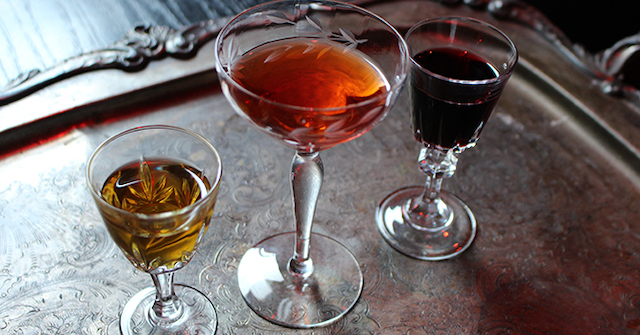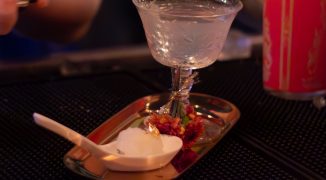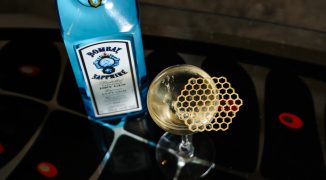There are moments in the craft cocktail world in which it seems that no category is left to innovate upon. For many, after dinner drinks — once known, especially in the United States, for syrupy, sweet concoctions — is this new frontier. Often, these innovators are bartenders in restaurants, where there is, well, dinner.
“This part of our cocktail menu really became something that we put considerable thought into when I started putting an increased focus on beverage pairing for an entire meal, and how to best complement different flavor profiles,” says Doug Petry, bar manager at RYE in Louisville. “Our kitchen produces a very wide spectrum of cuisine, so once I began to gain an understanding of how to build a progression of beverages throughout a meal, the next logical step was to delve into after dinner drinks. With the increased availability of different amari over the past couple of years, there was suddenly a vastly expansive world of unique ingredients to explore.”
Petry is passionate about demystifying unfamiliar liqueurs for his guests, who might be at his restaurant for the food, rather than the cocktails. “Rather than simply listing nonino quintessentia, we offer a brief description: ‘herbal bitter, orange and caramel sweetness’ which not only allows the guest a better understanding of the amaro itself, but also how that ingredient will translate in one of the after dinner cocktails that we offer.”
It’s clear to Petry that after dinner drink habits have shifted. “Five years ago, I saw a lot of dessert wine, cognac and bourbon ordered at the end of a meal,” he says. “But now, I am seeing a lot of guests explore more bitter and herbaceous drinks.”
Harsh Dayalani, former Beverage Program Director for the recently closed Tapestry in NYC and Certified Sommelier, sees an even larger pattern. “After dinner drinks these days have taken a major rise in the beverage industry,” he says. “Cocktails are heavily based on them, as guests say they don’t make them feel heavier after dinner. One drink often turns into several with after dinner drinks.”
Dayalani has made a point of discovering new liqueurs (and new ways to use beloved liqueurs) while traveling in Italy, Greece, France and Spain. “Amari, Chartreuse, Ouzo and Cognacs are some of my favorites for their distinctive tastes that pair so well with food and combine well with cocktails, creating an entirely different experience than on their own,” he says.
Dayalani isn’t alone in finding inspiration outside the United States. “In my experience bartending in the United States versus internationally, I’ve noticed after dinner cocktails are significantly more popular in Europe than in the United States,” says Vincenzo Marianella, head barman at Copa d’Oro in Santa Monica. He’s noticed that some restaurateurs are resistant to the idea of adding after dinner drinks to their menu, but for him, they are crucial to the program. “I’m a firm believer in after dinner cocktails because I feel like they are the perfect complement to dessert and the overall dining experience at a restaurant,” he says. Here he touches on something that came up again and again in interviews: a restaurant can take advantage of pairings and complement a meal in a way a bar cannot. Bars serving after dinner drinks can offer something delicious, but it isn’t the same experience as the one you’ll find at a restaurant.
 At The Hake in La Jolla, California, beverage curator Joan Villanueva plays on the tradition of desserts presented on a cart by serving cocktails in the same manner. (Photo: Courtesy of The Hake.)
At The Hake in La Jolla, California, beverage curator Joan Villanueva plays on the tradition of desserts presented on a cart by serving cocktails in the same manner. (Photo: Courtesy of The Hake.)
You’ll find one such experiential factor at The Hake in La Jolla, where Joan Villanueva, beverage curator, has added a roving drink cart, reminiscent of both the classic bar cart and the not so distant dessert cart. “I have seen dessert carts that do table side Crepe Suzette and whatnot,” says Villanueva, on his inspiration. “I asked: ‘can’t we do the same with after dinner drinks?’’ In spite of any preconceived notions you might have, this is hardly your average dessert cart. One current cocktail, the Bay Fog, features St. George coffee liqueur, Luxardo maraschino, chai tea and cream. Villanueva not only features the cart, but always has specifically designated after dinner cocktails on his menu.
One of the lines you walk with after dinner drinks is balancing a desire for something that functions like a dessert with those guests who are looking for something to aid in digestion. “When making after-dinner cocktails, use a gentle touch when incorporating strong and/or bitter liqueurs,” says Annie Beebe-Tron, Beverage Director at The Ladies’ Room and Fat Rice in Chicago. “These are cocktails meant to be sipped and not just shot as a medicinal-style remedy. Make sure they are well-diluted and drinkable from start to finish. We also often place after dinner drinks (both cocktails and liqueurs) in the dessert section of the menu, occasionally positioned as dessert pairings. This is an easy way to remind guests that these items are available and intended to be consumed near the end of their meal, without having to rely just on staff suggestions.” Staff education is key for Beebe-Tron, especially if you plan to feature ingredients off the beaten path (which she heartily recommends).
Beebe-Tron’s program includes a wide variety of housemade liqueurs, a staple of this category on her menus. While she does make cocktails from some of them, often, she allows these unique liqueurs to stand on their own. “We usually choose to serve spirits on their own when their flavor is delicate or nuanced to the point where mixing it into a cocktail is unnecessary or might kill it. This is particularly true with items like our madeira selection and our house ‘campari.’ That being said, we also offer the house ‘campari’ in a classic spritz cocktail, since it’s a delicate enough preparation to feature it well. Our house ‘campari’ is a relatively simple infusion, combining dried and fresh foraged citrus peels with gentian roots and traditional cochineal bugs for that traditional vivid red color.” In spite of all of this, Beebe-Tron doesn’t consider herself an innovator, crediting those who came before. “Let’s be real, our grandparents (especially those of European immigrant descent) were pros at the after dinner drink!”
Dayalani’s advice to those just wading into this exciting category? “Play around, eat around and understand the basic ingredients and the ways they are made, when it comes to after dinner drinks,” he says. “Know the type of concept your restaurant is and then curate a list and menu according to the flavors and spices you use. This not only helps you innovate, but also makes it easier for you to complement the cuisine with your desserts.”




